Mesa 24.2.0 released with a new shader cache implementation
 .
.
Read the full article on GamingOnLinux.
 .
.
Read the full article on GamingOnLinux.
We’ve finally seen these ‘E3 canceled’ headlines for the last time. The ESA has announced today that owing to a challenging media landscape, they’re done...
The post E3’s corpse has finally been laid to rest appeared first on ISK Mogul Adventures. Written by .

There’s growing evidence, via datamining and voice actor leaks, that Valve is working on a brand new, yet-to-be-announced Half-Life video game. And before you go running to tell folks that, finally, Half-Life 3 is confirmed, keep in mind that we don’t know if that’s true.

The accelerating buildout of solar farms on Earth is already hitting speed bumps, including public pushback against the large tracts of land required and a ballooning backlog of requests for new transmission lines and grid connections. Energy experts have been warning that electricity is likely to get more expensive and less reliable unless renewable power that waxes and wanes under inconstant sunlight and wind is backed up by generators that can run whenever needed. To space enthusiasts, that raises an obvious question: Why not stick solar power plants where the sun always shines?
Space-based solar power is an idea so beautiful, so tantalizing that some argue it is a wish worth fulfilling. A constellation of gigantic satellites in geosynchronous orbit (GEO) nearly 36,000 kilometers above the equator could collect sunlight unfiltered by atmosphere and uninterrupted by night (except for up to 70 minutes a day around the spring and fall equinoxes). Each megasat could then convert gigawatts of power into a microwave beam aimed precisely at a big field of receiving antennas on Earth. These rectennas would then convert the signal to usable DC electricity.
The thousands of rocket launches needed to loft and maintain these space power stations would dump lots of soot, carbon dioxide, and other pollutants into the stratosphere, with uncertain climate impacts. But that might be mitigated, in theory, if space solar displaced fossil fuels and helped the world transition to clean electricity.
The glamorous vision has inspired numerous futuristic proposals. Japan’s space agency has presented a road map to deployment. Space authorities in China aim to put a small test satellite in low Earth orbit (LEO) later this decade. Ideas to put megawatt-scale systems in GEO sometime in the 2030s have been floated but not yet funded.
The U.S. Naval Research Laboratory has already beamed more than a kilowatt of power between two ground antennas about a kilometer apart. It also launched in 2023 a satellite that used a laser to transmit about 1.5 watts, although the beam traveled less than 2 meters and the system had just 11 percent efficiency. A team at Caltech earlier this year wrapped up a mission that used a small satellite in LEO to test thin-film solar cells, flexible microwave-power circuitry, and a small collapsible deployment mechanism. The energy sent Earthward by the craft was too meager to power a lightbulb, but it was progress nonetheless.
The European Space Agency (ESA) debuted in 2022 its space-based solar-power program, called Solaris, with an inspiring (but entirely fantastical) video animation. The program’s director, Sanjay Vijendran, told IEEE Spectrum that the goal of the effort is not to develop a power station for space. Instead, the program aims to spend three years and €60 million (US $65 million) to figure out whether solar cells, DC-to-RF converters, assembly robots, beam-steering antennas, and other must-have technologies will improve drastically enough over the next 10 to 20 years to make orbital solar power feasible and competitive. Low-cost, low-mass, and space-hardy versions of these technologies would be required, but engineers trying to draw up detailed plans for such satellites today find no parts that meet the tough requirements.
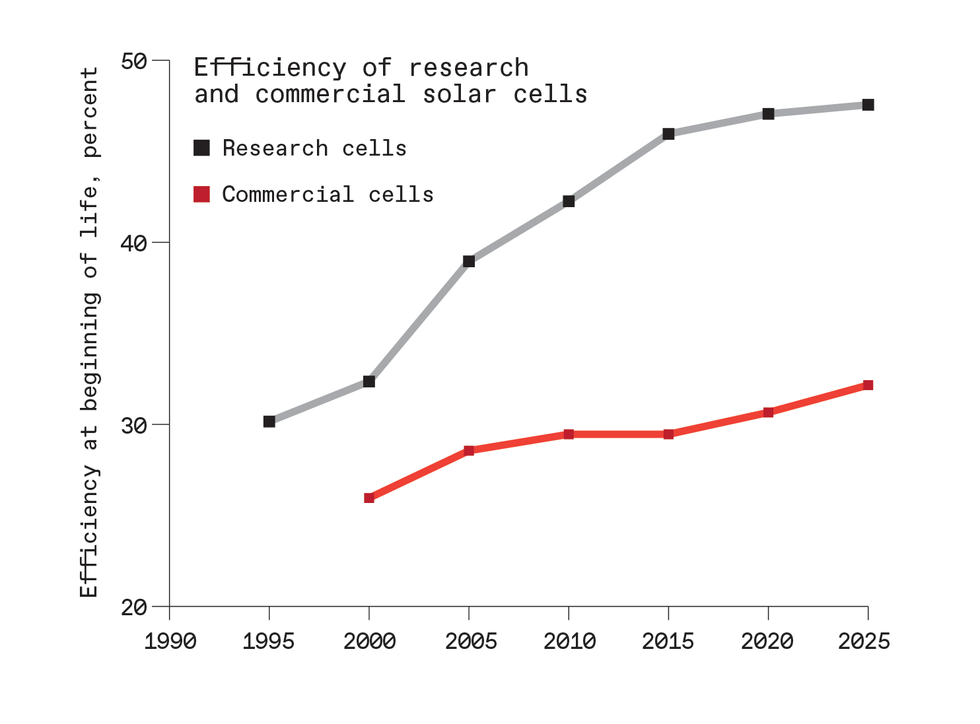 Not so fast: The real-world efficiency of commercial, space-qualified solar cells has progressed much more slowly than records set in highly controlled research experiments, which often use exotic materials or complex designs that cannot currently be mass-produced. Points plotted here show the highest efficiency reported in five-year intervals.HENRI BARDE; DATA FROM NATIONAL RENEWABLE ENERGY LABORATORY (RESEARCH CELLS) AND FROM MANUFACTURER DATA SHEETS AND PRESENTATIONS (COMMERCIAL CELLS)
Not so fast: The real-world efficiency of commercial, space-qualified solar cells has progressed much more slowly than records set in highly controlled research experiments, which often use exotic materials or complex designs that cannot currently be mass-produced. Points plotted here show the highest efficiency reported in five-year intervals.HENRI BARDE; DATA FROM NATIONAL RENEWABLE ENERGY LABORATORY (RESEARCH CELLS) AND FROM MANUFACTURER DATA SHEETS AND PRESENTATIONS (COMMERCIAL CELLS)
With the flurry of renewed attention, you might wonder: Has extraterrestrial solar power finally found its moment? As the recently retired head of space power systems at ESA—with more than 30 years of experience working on power generation, energy storage, and electrical systems design for dozens of missions, including evaluation of a power-beaming experiment proposed for the International Space Station—I think the answer is almost certainly no.
Despite mounting buzz around the concept, I and many of my former colleagues at ESA are deeply skeptical that these large and complex power systems could be deployed quickly enough and widely enough to make a meaningful contribution to the global energy transition. Among the many challenges on the long and formidable list of technical and societal obstacles: antennas so big that we cannot even simulate their behavior.
Here I offer a road map of the potential chasms and dead ends that could doom a premature space solar project to failure. Such a misadventure would undermine the credibility of the responsible space agency and waste capital that could be better spent improving less risky ways to shore up renewable energy, such as batteries, hydrogen, and grid improvements. Champions of space solar power could look at this road map as a wish list that must be fulfilled before orbital solar power can become truly appealing to electrical utilities.
For decades, enthusiasm for the possibility of drawing limitless, mostly clean power from the one fusion reactor we know works reliably—the sun—has run hot and cold. A 1974 study that NASA commissioned from the consultancy Arthur D. Little bullishly recommended a 20-year federal R&D program, expected to lead to a commercial station launching in the mid-1990s. After five years of work, the agency delivered a reference architecture for up to 60 orbiting power stations, each delivering 5 to 10 gigawatts of baseload power to major cities. But officials gave up on the idea when they realized that it would cost over $1 trillion (adjusted for inflation) and require hundreds of astronauts working in space for decades, all before the first kilowatt could be sold.
NASA did not seriously reconsider space solar until 1995, when it ordered a “fresh look” at the possibility. That two-year study generated enough interest that the U.S. Congress funded a small R&D program, which published plans to put up a megawatt-scale orbiter in the early 2010s and a full-size power plant in the early 2020s. Funding was cut off a few years later, with no satellites developed.
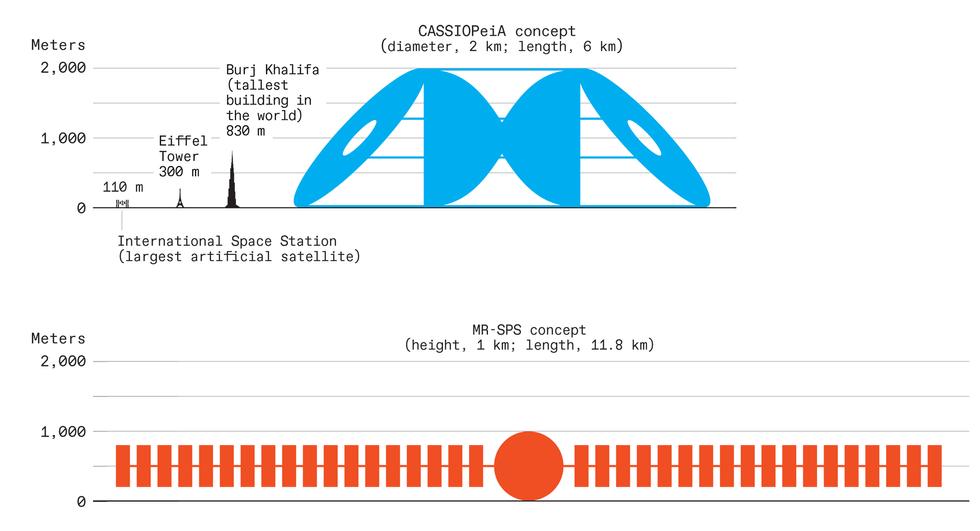 Because of the physics of power transmission from geosynchronous orbit, space power satellites must be enormous—hundreds of times larger than the International Space Station and even dwarfing the tallest skyscrapers—to generate electricity at a competitive price. The challenges for their engineering and assembly are equally gargantuan. Chris Philpot
Because of the physics of power transmission from geosynchronous orbit, space power satellites must be enormous—hundreds of times larger than the International Space Station and even dwarfing the tallest skyscrapers—to generate electricity at a competitive price. The challenges for their engineering and assembly are equally gargantuan. Chris Philpot
Then, a decade ago, private-sector startups generated another flurry of media attention. One, Solaren, even signed a power-purchase agreement to deliver 200 megawatts to utility customers in California by 2016 and made bold predictions that space solar plants would enter mass production in the 2020s. But the contract and promises went unfulfilled.
The repeated hype cycles have ended the same way each time, with investors and governments balking at the huge investments that must be risked to build a system that cannot be guaranteed to work. Indeed, in what could presage the end of the current hype cycle, Solaris managers have had trouble drumming up interest among ESA’s 22 member states. So far only the United Kingdom has participated, and just 5 percent of the funds available have been committed to actual research work.
Even space-solar advocates have recognized that success clearly hinges on something that cannot be engineered: sustained political will to invest, and keep investing, in a multidecade R&D program that ultimately could yield machines that can’t put electricity on the grid. In that respect, beamed power from space is like nuclear fusion, except at least 25 years behind.
In the 1990s, the fusion community succeeded in tapping into national defense budgets and cobbled together the 35-nation, $25 billion megaproject ITER, which launched in 2006. The effort set records for delays and cost overruns, and yet a prototype is still years from completion. Nevertheless, dozens of startups are now testing new fusion-reactor concepts. Massive investments in space solar would likely proceed in the same way. Of course, if fusion succeeds, it would eclipse the rationale for solar-energy satellites.
The U.S. and European space agencies have recently released detailed technical analyses of several space-based solar-power proposals. [See diagrams.] These reports make for sobering reading.
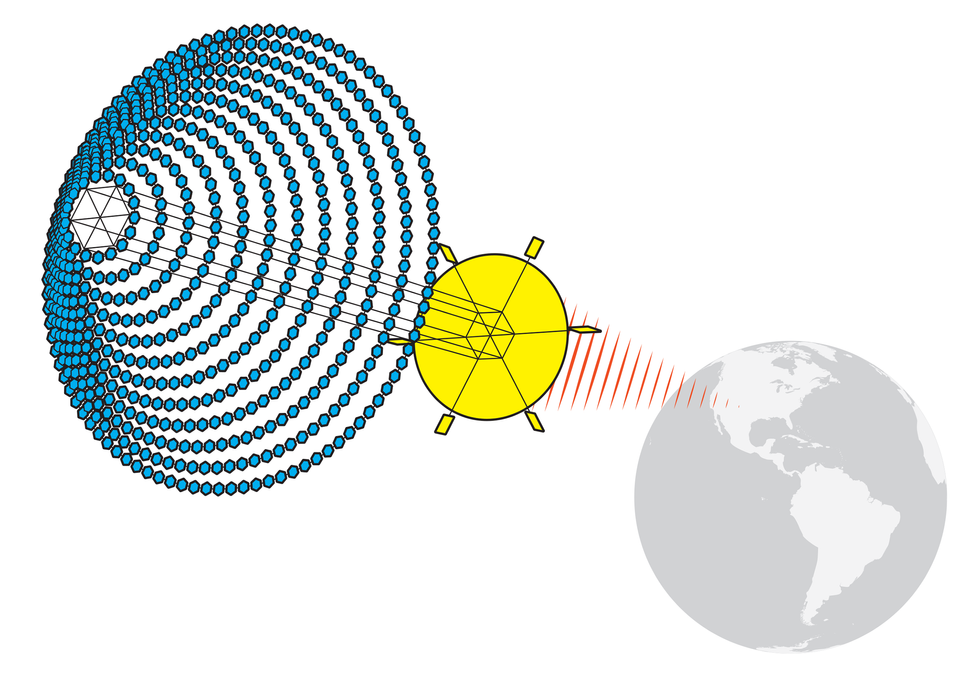
Proposed by: John C. Mankins, former NASA physicist
Features: Thin-film reflectors (conical array) track the sun and concentrate sunlight onto an Earth-facing energy-conversion array that has photovoltaic (PV) panels on one side, microwave antennas on the other, and power distribution and control electronics in the middle. Peripheral modules adjust the station’s orbit and orientation.
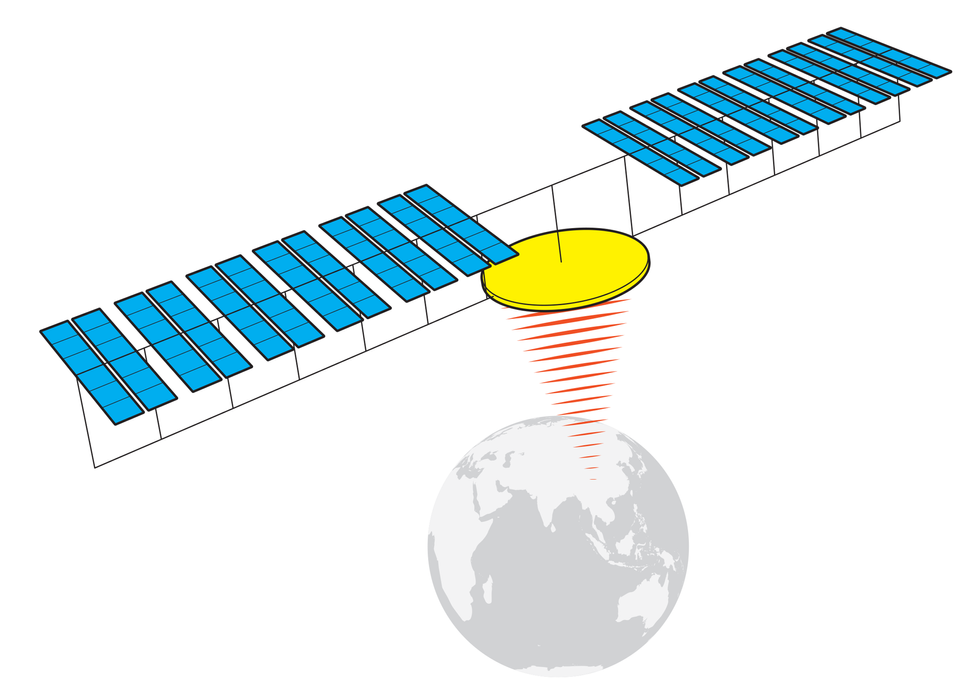
Proposed by: China Academy of Space Technology
Features: Fifty PV solar arrays, each 200 meters wide and 600 meters long, track the sun and send power through rotating high-power joints and perpendicular trusses to a central microwave-conversion and transmission array that points 128,000 antenna modules at the receiving station on Earth.
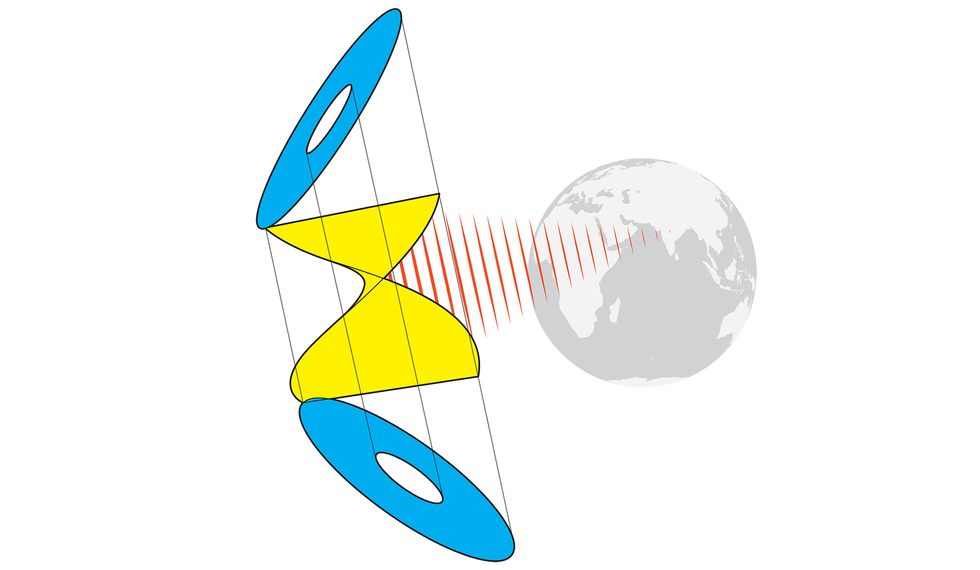
Proposed by: Ian Cash, chief architect, Space Solar Group Holdings
Features: Circular thin-film reflectors track the sun and bounce light onto a helical array that includes myriad small PV cells covered by Fresnel-lens concentrators, power-conversion electronics, and microwave dipole antennas. The omnidirectional antennas must operate in sync to steer the beam as the station rotates relative to the Earth.
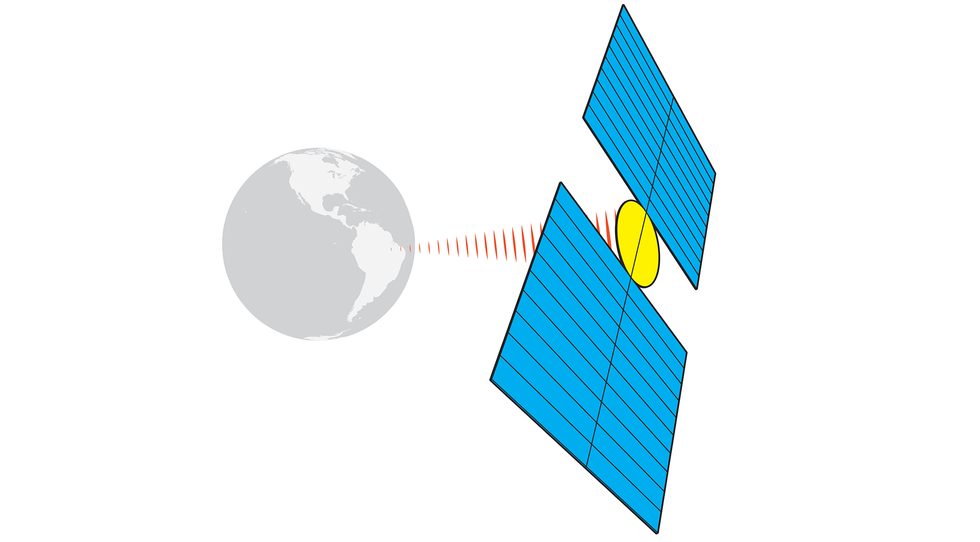
Proposed by: Thales Alenia Space
Features: Nearly 8,000 flexible solar arrays, each 10 meters wide and 80 meters long, are unfurled from roll-out modules and linked together to form two wings. The solar array remains pointed at the sun, so the central transmitter must rotate and also operate with great precision as a phased-array antenna to continually steer the beam onto the ground station.
Electricity made this way,
NASA reckoned in its 2024 report, would initially cost 12 to 80 times as much as power generated on the ground, and the first power station would require at least $275 billion in capital investment. Ten of the 13 crucial subsystems required to build such a satellite—including gigawatt-scale microwave beam transmission and robotic construction of kilometers-long, high-stiffness structures in space—rank as “high” or “very high” technical difficulty, according to a 2022 report to ESA by Frazer-Nash, a U.K. consultancy. Plus, there is no known way to safely dispose of such enormous structures, which would share an increasingly crowded GEO with crucial defense, navigation, and communications satellites, notes a 2023 ESA study by the French-Italian satellite maker Thales Alenia Space.
An alternative to microwave transmission would be to beam the energy down to Earth as reflected sunlight. Engineers at Arthur D. Little described the concept in a 2023 ESA study in which they proposed encircling the Earth with about 4,000 aimable mirrors in LEO. As each satellite zips overhead, it would shine an 8-km-wide spotlight onto participating solar farms, allowing the farms to operate a few extra hours each day (if skies are clear). In addition to the problems of clouds and light pollution, the report noted the thorny issue of orbital debris, estimating that each reflector would be penetrated about 75 billion times during its 10-year operating life.
My own assessment, presented at the 2023 European Space Power Conference and published by IEEE, pointed out dubious assumptions and inconsistencies in four space-solar designs that have received serious attention from government agencies. Indeed, the concepts detailed so far all seem to stand on shaky technical ground.
The high costs and hard engineering problems that prevent us from building orbital solar-power systems today arise mainly from the enormity of these satellites and their distance from Earth, both of which are unavoidable consequences of the physics of this kind of energy transmission. Only in GEO can a satellite stay (almost) continuously connected to a single receiving station on the ground. The systems must beam down their energy at a frequency that passes relatively unimpeded through all kinds of weather and doesn’t interfere with critical radio systems on Earth. Most designs call for 2.45 or 5.8 gigahertz, within the range used for Wi-Fi. Diffraction will cause the beam to spread as it travels, by an amount that depends on the frequency.
Thales Alenia Space estimated that a transmitter in GEO must be at least 750 meters in diameter to train the bright center of a 5.8-GHz microwave beam onto a ground station of reasonable area over that tremendous distance—65 times the altitude of LEO satellites like Starlink. Even using a 750-meter transmitter, a receiver station in France or the northern United States would fill an elliptical field covering more than 34 square kilometers. That’s more than two-thirds the size of Bordeaux, France, where I live.
“Success hinges on something that cannot be engineered: sustained political will to keep investing in a multidecade R&D program that ultimately could yield machines that can’t put electricity on the grid.”
Huge components come with huge masses, which lead to exorbitant launch costs. Thales Alenia Space estimated that the transmitter alone would weigh at least 250 tonnes and cost well over a billion dollars to build, launch, and ferry to GEO. That estimate, based on ideas from the Caltech group that have yet to be tested in space, seems wildly optimistic; previous detailed transmitter designs are about 30 times heavier.
Because the transmitter has to be big and expensive, any orbiting solar project will maximize the power it sends through the beam, within acceptable safety limits. That’s why the systems evaluated by NASA, ESA, China, and Japan are all scaled to deliver 1–2 GW, the maximum output that utilities and grid operators now say they are willing to handle. It would take two or three of these giant satellites to replace one large retiring coal or nuclear power station.
Energy is lost at each step in the conversion from sunlight to DC electricity, then to microwaves, then back to DC electricity and finally to a grid-compatible AC current. It will be hard to improve much on the 11 percent end-to-end efficiency seen in recent field trials. So the solar arrays and electrical gear must be big enough to collect, convert, and distribute around 9 GW of power in space just to deliver 1 GW to the grid. No electronic switches, relays, and transformers have been designed or demonstrated for spacecraft that can handle voltages and currents anywhere near the required magnitude.
Some space solar designs, such as SPS-ALPHA and CASSIOPeiA, would suspend huge reflectors on kilometers-long booms to concentrate sunlight onto high-efficiency solar cells on the back side of the transmitter or intermingled with antennas. Other concepts, such as China’s MR-SPS and the design proposed by Thales Alenia Space, would send the currents through heavy, motorized rotating joints that allow the large solar arrays to face the sun while the transmitter pivots to stay fixed on the receiving station on Earth.
 All space solar-power concepts that send energy to Earth via a microwave beam would need a large receiving station on the ground. An elliptical rectenna field 6 to 10 kilometers wide would be covered with antennas and electronics that rectify the microwaves into DC power. Additional inverters would then convert the electricity to grid-compatible AC current.Chris Philpot
All space solar-power concepts that send energy to Earth via a microwave beam would need a large receiving station on the ground. An elliptical rectenna field 6 to 10 kilometers wide would be covered with antennas and electronics that rectify the microwaves into DC power. Additional inverters would then convert the electricity to grid-compatible AC current.Chris Philpot
The net result, regardless of approach, is an orbiting power station that spans several kilometers, totals many thousands of tonnes, sends gigawatts of continuous power through onboard electronics, and comprises up to a million modules that must be assembled in space—by robots. That is a gigantic leap from the largest satellite and solar array ever constructed in orbit: the 420-tonne, 109-meter International Space Station (ISS), whose 164 solar panels produce less than 100 kilowatts to power its 43 modules.
The ISS has been built and maintained by astronauts, drawing on 30 years of prior experience with the Salyut, Skylab, and Mir space stations. But there is no comparable incremental path to a robot-assembled power satellite in GEO. Successfully beaming down a few megawatts from LEO would be an impressive achievement, but it wouldn’t prove that a full-scale system is feasible, nor would the intermittent power be particularly interesting to commercial utilities.
NASA’s 2024 report used sensitivity analysis to look for advances, however implausible, that would enable orbital solar power to be commercially competitive with nuclear fission and other low-emissions power. To start, the price of sending a tonne of cargo to LEO on a large reusable rocket, which has fallen 36 percent over the past 10 years, would have to drop by another two-thirds, to $500,000. This assumes that all the pieces of the station could be dropped off in low orbit and then raised to GEO over a period of months by space tugs propelled by electrical ion thrusters rather than conventional rockets. The approach would slow the pace of construction and add to the overall mass and cost. New tugs would have to be developed that could tow up to 100 times as much cargo as the biggest electric tugs do today. And by my calculations, the world’s annual production of xenon—the go-to propellant for ion engines—is insufficient to carry even a single solar-power satellite to GEO.
Thales Alenia Space looked at a slightly more realistic option: using a fleet of conventional rockets as big as SpaceX’s new Starship—the largest rocket ever built—to ferry loads from LEO to GEO, and then back to LEO for refueling from an orbiting fuel depot. Even if launch prices plummeted to $200,000 a tonne, they calculated, electricity from their system would be six times as expensive as NASA’s projected cost for a terrestrial solar farm outfitted with battery storage—one obvious alternative.
What else would have to go spectacularly right? In NASA’s cost-competitive scenario, the price of new, specialized spaceships that could maintain the satellite for 30 years—and then disassemble and dispose of it—would have to come down by 90 percent. The efficiency of commercially produced, space-qualified solar cells would have to soar from 32 percent today to 40 percent, while falling in cost. Yet over the past 30 years, big gains in the efficiency of research cells have not translated well to the commercial cells available at low cost [see chart, “Not So Fast”].
Is it possible for all these things to go right simultaneously? Perhaps. But wait—there’s more that can go wrong.
Let’s start with temperature. Gigawatts of power coursing through the system will make heat removal essential because solar cells lose efficiency and microcircuits fry when they get too hot. A couple of dozen times a year, the satellite will pass suddenly into the utter darkness of Earth’s shadow, causing temperatures to swing by around 300 °C, well beyond the usual operating range of electronics. Thermal expansion and contraction may cause large structures on the station to warp or vibrate.
Then there’s the physical toll of operating in space. Vibrations and torques exerted by altitude-control thrusters, plus the pressure of solar radiation on the massive sail-like arrays, will continually bend and twist the station this way and that. The sprawling arrays will suffer unavoidable strikes from man-made debris and micrometeorites, perhaps even a malfunctioning construction robot. As the number of space power stations increases, we could see a rapid rise in the threat of Kessler syndrome, a runaway cascade of collisions that is every space operator’s nightmare.
Probably the toughest technical obstacle blocking space solar power is a basic one: shaping and aiming the beam. The transmitter is not a dish, like a radio telescope in reverse. It’s a phased array, a collection of millions of little antennas that must work in near-perfect synchrony, each contributing its piece to a collective waveform aimed at the ground station.
Like people in a stadium crowd raising their arms on cue to do “the wave,” coordination of a phased array is essential. It will work properly only if every element on the emitter syncs the phase of its transmission to align precisely with the transmission of its neighbors and with an incoming beacon signal sent from the ground station. Phase errors measured in picoseconds can cause the microwave beam to blur or drift off its target. How can the system synchronize elements separated by as much as a kilometer with such incredible accuracy? If you have the answer, please patent and publish it, because this problem currently has engineers stumped.
There is no denying the beauty of the idea of turning to deep space for inexhaustible electricity. But nature gets a vote. As Lao Tzu observed long ago in the Tao Te Ching, “The truth is not always beautiful, nor beautiful words the truth.”


Enlarge / AMD's depiction of a game playing without FreeSync (left) and with FreeSync (right). (credit: AMD)
AMD announced this week that it has ceased FreeSync certification for monitors or TVs whose maximum refresh rates are under 144 Hz. Previously, FreeSync monitors and TVs could have refresh rates as low as 60 Hz, allowing for screens with lower price tags and ones not targeted at serious gaming to carry the variable refresh-rate technology.
AMD also boosted the refresh-rate requirements for its higher AdaptiveSync tiers, FreeSync Premium and FreeSync Premium Pro, from 120 Hz to 200 Hz.
Here are the new minimum refresh-rate requirements for FreeSync, which haven't changed for laptops.